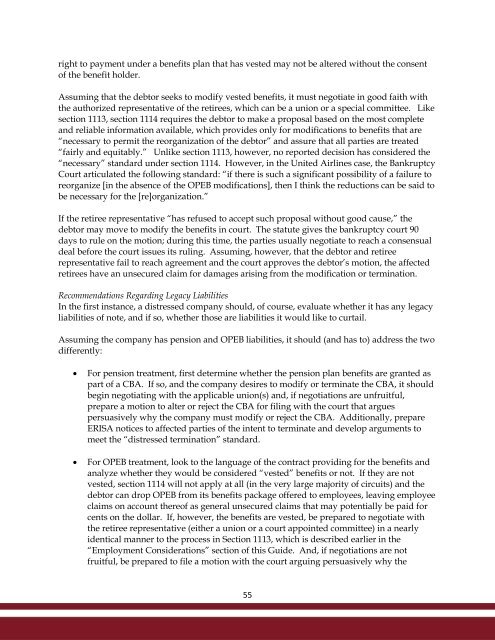Guide-for-Nonprofit-Organizations-Bankruptcy-Issues-FINAL-with-ads
Guide-for-Nonprofit-Organizations-Bankruptcy-Issues-FINAL-with-ads
Guide-for-Nonprofit-Organizations-Bankruptcy-Issues-FINAL-with-ads
- No tags were found...
Create successful ePaper yourself
Turn your PDF publications into a flip-book with our unique Google optimized e-Paper software.
ight to payment under a benefits plan that has vested may not be altered <strong>with</strong>out the consentof the benefit holder.Assuming that the debtor seeks to modify vested benefits, it must negotiate in good faith <strong>with</strong>the authorized representative of the retirees, which can be a union or a special committee. Likesection 1113, section 1114 requires the debtor to make a proposal based on the most completeand reliable in<strong>for</strong>mation available, which provides only <strong>for</strong> modifications to benefits that are―necessary to permit the reorganization of the debtor‖ and assure that all parties are treated―fairly and equitably.‖ Unlike section 1113, however, no reported decision has considered the―necessary‖ standard under section 1114. However, in the United Airlines case, the <strong>Bankruptcy</strong>Court articulated the following standard: ―if there is such a significant possibility of a failure toreorganize [in the absence of the OPEB modifications], then I think the reductions can be said tobe necessary <strong>for</strong> the [re]organization.‖If the retiree representative ―has refused to accept such proposal <strong>with</strong>out good cause,‖ thedebtor may move to modify the benefits in court. The statute gives the bankruptcy court 90days to rule on the motion; during this time, the parties usually negotiate to reach a consensualdeal be<strong>for</strong>e the court issues its ruling. Assuming, however, that the debtor and retireerepresentative fail to reach agreement and the court approves the debtor’s motion, the affectedretirees have an unsecured claim <strong>for</strong> damages arising from the modification or termination.Recommendations Regarding Legacy LiabilitiesIn the first instance, a distressed company should, of course, evaluate whether it has any legacyliabilities of note, and if so, whether those are liabilities it would like to curtail.Assuming the company has pension and OPEB liabilities, it should (and has to) address the twodifferently:For pension treatment, first determine whether the pension plan benefits are granted aspart of a CBA. If so, and the company desires to modify or terminate the CBA, it shouldbegin negotiating <strong>with</strong> the applicable union(s) and, if negotiations are unfruitful,prepare a motion to alter or reject the CBA <strong>for</strong> filing <strong>with</strong> the court that arguespersuasively why the company must modify or reject the CBA. Additionally, prepareERISA notices to affected parties of the intent to terminate and develop arguments tomeet the ―distressed termination‖ standard.For OPEB treatment, look to the language of the contract providing <strong>for</strong> the benefits andanalyze whether they would be considered ―vested‖ benefits or not. If they are notvested, section 1114 will not apply at all (in the very large majority of circuits) and thedebtor can drop OPEB from its benefits package offered to employees, leaving employeeclaims on account thereof as general unsecured claims that may potentially be paid <strong>for</strong>cents on the dollar. If, however, the benefits are vested, be prepared to negotiate <strong>with</strong>the retiree representative (either a union or a court appointed committee) in a nearlyidentical manner to the process in Section 1113, which is described earlier in the―Employment Considerations‖ section of this <strong>Guide</strong>. And, if negotiations are notfruitful, be prepared to file a motion <strong>with</strong> the court arguing persuasively why the55


